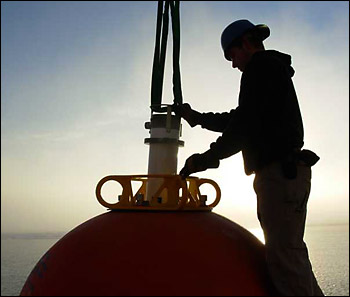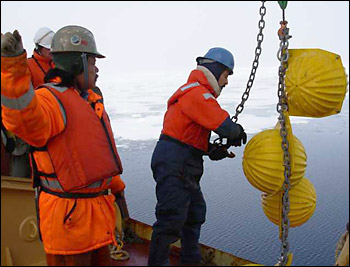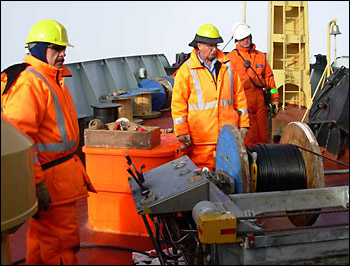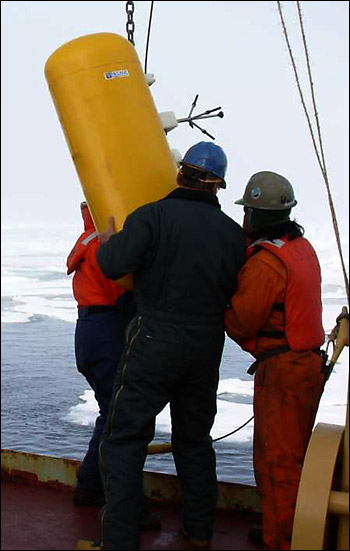Please note: You are viewing
the unstyled version of this website. Either your browser does not support CSS
(cascading style sheets) or it has been disabled. Skip
navigation.
Kris NewhallAugust 24, 2006
In fact, the ship was on station early Thursday morning to initially survey the area in hopes of finding a clear opening so that the WHOI mooring team, along with the ship's crew and officers, could get to work and deploy Mooring A, the first of four WHOI moorings that was recovered (see Dispatch 13), then will be deployed this cruise. For a mooring recovery, the Captain needs to spend more time breaking ice and trying to create the largest open water pond as possible. But for a deployment, minimal ice needs to be broken and only a small open water area is needed. Furthermore, the ship uses its Wartsila Bubbler System to push any impeding ice away from the deployment area. Much of the morning, therefore, is spent on deck work; i.e., connecting the acoustic releases and bottom pressure recorder (BPR) to the anchor, assembling the Benthos floatation spheres and organizing them for deployment, and installing the upward looking sonar (ULS) in the top sphere. Also, all of the wooden reels which contain the mooring's jacketed wire rope are assembled, staged, and organized by their serial number. This is important because the mooring's recorder has to keep track of which wire shot is going over the side and when. Traditionally, for most sub surface moorings around the world, where the length of the mooring can be trailed out behind the ship before the anchor is launched, the top floats are deployed first and the anchor last. This keeps the tension on the wire low during the entire operation. However, because of high concentrations of sea ice in these remote areas of the Beaufort Sea, the mooring must be deployed vertically from the ship's starboard A-frame with the anchor going over the side first. To safely handle the extra tension, we employ a specially designed Lebus winch. After lunch, we are in position and the crew is ready. Because the mooring is approximately 3,800 m (over 2 miles) long, there are many wooden reels of wire (most consisting of 500 meter, or 1600 ft, lengths) that need to be added to the mooring as we progress. In order to add these wire shots, the process requires that we stop the mooring off, in other words, to take the weight off of the winch using a 'Yale' grip, which holds the wire, essentially holding the mooring in place. Changing reels is an integral part of both the recovery and deployment process and requires the aid of everyone on deck. Finally, when almost half of the wire is already in the water, it's time to put the McLane Moored Profiler (MMP) on the 1,995 m (over 1 mile) shot of wire. The MMP is the instrument responsible for profiling the water column to obtain measurements of temperature, salinity, and currents versus pressure. Above the profiler there is an acoustic transponder, just below the top sphere, which aids in the recovery process. By sending acoustic signals in the water, much like the releases, the transponder tells us where the top sphere is located. When everyone, including the Captain, was ready, the top sphere was moved into position and shackled to the mooring. Using a quick release hook, the sphere was lowered to the surface and released; it took approximately 30-40 seconds for the anchor to take the mooring to the bottom. Now the mooring will patiently wait for recovery next year, and hopefully will compile as much useful data as it did this year. Last updated: October 7, 2019 | |||||||||||||||||||||
Copyright ©2007 Woods Hole Oceanographic Institution, All Rights Reserved, Privacy Policy. | |||||||||||||||||||||






